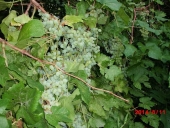
 1
1








Kristen Schroder wrote:
There seems to be a contradiction between permaculture and native prairie plants.
Idle dreamer








Idle dreamer








Casie Becker wrote:plants that were more palatable to their tastes. With this in mind, plants that focused their development on more survival traits may not be as palatable as you'd hope.
Idle dreamer





 1
1




Idle dreamer




Tyler Ludens wrote: The combination of cold winters and hot dry summers is just killer. I would like to see more information about food forests under these conditions. I don't really know where to look for it, or even if many people are doing work in that area. Most food forests seem to be in subtropical or moist climates.

 1
1




 1
1





 1
1




Invasive plants are Earth's way of insisting we notice her medicines. Stephen Herrod Buhner
Everyone learns what works by learning what doesn't work. Stephen Herrod Buhner









 1
1




Idle dreamer




Kristen Schroder wrote:i also found a description for our climate- humid subtropical with dry summers and wet winters. which is definitely the opposite of what much in the literature i've found speaks to
Invasive plants are Earth's way of insisting we notice her medicines. Stephen Herrod Buhner
Everyone learns what works by learning what doesn't work. Stephen Herrod Buhner

 4
4





 I think it is good to help the natives, as Tyler said, because the mainstream is so against them. But we needn’t limit ourselves to only those.
I think it is good to help the natives, as Tyler said, because the mainstream is so against them. But we needn’t limit ourselves to only those.
 . Permaculture talks about using human intervention like compost and mulch to speed up natural processes. The land would repair itself eventually, if humans just quit messing up the process, but it might take 200 years. With compost, mulch, some minimal aeration, some temporary irrigation, maybe some animals, a good permaculture designer can get it going in just a few years by mimicking natural processes, but speeding them up.
. Permaculture talks about using human intervention like compost and mulch to speed up natural processes. The land would repair itself eventually, if humans just quit messing up the process, but it might take 200 years. With compost, mulch, some minimal aeration, some temporary irrigation, maybe some animals, a good permaculture designer can get it going in just a few years by mimicking natural processes, but speeding them up.
 The forums here are great, too, and there are a lot of good books. But Gaia is a great place to start. Plus observation, of course.
The forums here are great, too, and there are a lot of good books. But Gaia is a great place to start. Plus observation, of course.

|
ice is for people that are not already cool. Chill with this tiny ad:
The new kickstarter is now live!
https://www.kickstarter.com/projects/paulwheaton/garden-cards
|




